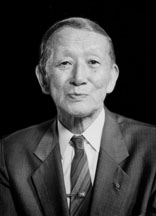Shinichi Suzuki facts for kids
Quick facts for kids
Shinichi Suzuki
|
|
|---|---|
 |
|
| Background information | |
| Native name |
鈴木鎮一
|
| Birth name | Shinichi Suzuki |
| Also known as | Shin'ichi Suzuki |
| Born | 17 October 1898 Nagoya, Japan |
| Origin | Japan |
| Died | 26 January 1998 (aged 99) Matsumoto, Japan |
| Genres | Classical |
| Occupation(s) | Musician, violinist, pedagogue, philosopher |
| Instruments | Violin |
Shinichi Suzuki (born October 17, 1898 – died January 26, 1998) was a famous Japanese violinist, thinker, and teacher. He created the international Suzuki method for music education. This method helps people of all ages and skill levels learn music.
Suzuki was a very important teacher for children's music education. He believed that all children could learn well, especially in the right environment. He also thought that music education could help students build good character. Before him, it was rare for young children to learn classical instruments. It was even rarer for teachers to accept students without an audition. Suzuki taught children the violin from a very young age. His school in Matsumoto did not test students before they joined. He also trained some of the first Japanese violinists who became successful in Western classical music. Suzuki received many awards, including honorary doctorates in music. He was named a Living National Treasure of Japan. In 1993, he was even nominated for the Nobel Peace Prize.
Contents
Shinichi Suzuki's Life Story
Shinichi Suzuki was born in 1898 in Nagoya, Japan. He was one of twelve children. As a child, he worked in his father's violin factory. He helped put small wooden pieces called soundposts inside violins.
A family friend encouraged Shinichi to learn about Western culture. But his father thought playing music was not a good job for him. However, in 1916, when he was 17, Suzuki started to teach himself the violin. He was inspired by a recording of a famous violinist named Mischa Elman. He did not have a teacher, so he listened to recordings and tried to play like them.
When Suzuki was 26, a friend helped him go to Germany. There, Suzuki said he studied with a teacher named Karl Klingler. He also said he spent time with Albert Einstein. In Germany, he met and married Waltraud Prange.
After returning to Japan, he formed a string quartet with his brothers. He also started teaching music at schools in Tokyo. He became very interested in teaching young children to play the violin.
During World War II, his father's violin factory made parts for seaplanes. The factory was bombed, and one of Suzuki's brothers died. Suzuki and his wife had to move to different places to stay safe. After the war, Suzuki was asked to teach at a new music school. He agreed, but only if he could teach music to babies and very young children. He also took in one of his students, Koji, who had lost his parents in the war. Suzuki and his wife later moved to Matsumoto, where he continued to teach.
Shinichi Suzuki passed away at his home in Matsumoto, Japan, on January 26, 1998. He was 99 years old.
How Suzuki Changed Teaching
Shinichi Suzuki learned to play the violin as an adult. His own experiences and ideas shaped how he taught his students. His teaching methods have been combined with those of other famous educators like Orff and Montessori.
Suzuki believed strongly in "Talent Education." This idea says that talent, whether in music or anything else, can be developed in any child. He once said that all children can learn to speak their mother language very well. This shows the amazing power of the human mind. He thought this "mother language method" could help children learn many other things, including music. He believed that every child could achieve a high level of skill, even if not everyone reached the same top level.
Suzuki worked with other thinkers, like Glenn Doman. Doman studied how young children's brains develop. Suzuki and Doman both agreed that all young children have great potential.
Suzuki used these main ideas in his music schools:
- People learn from their environment.
- It's better to start learning early, not just for music, but for everything.
- Repeating what you learn helps you remember it.
- Teachers and parents must keep learning and growing. This helps them create a better learning place for children.
- The teaching method should show things clearly to the child. The teacher needs to know when, what, and how to teach.
Suzuki's "mother tongue" idea means children learn by watching and listening to their surroundings. This is how they learn their first language. The worldwide Suzuki movement still uses these ideas today. Suzuki always encouraged others to keep researching and improving how children are taught. He trained many teachers who then went back to their own countries. They helped spread the Suzuki method and philosophy around the world.
Suzuki's Philosophy
The Suzuki Talent Education, also known as the Suzuki Method, is a way of teaching music. It also includes a philosophy about helping children grow in every way. Suzuki's main rule was "character first, ability second." He truly believed that any child could learn.
Awards and Honors
- Order of the Rising Sun, Third Class (around 1970)
- Honorary Doctor of Music, New England Conservatory of Music (1966)
- Honorary Doctor of Music, University of Louisville (1967)
- Honorary Doctor of Music, University of Rochester Eastman School of Music (1972)
- Honorary Doctor of Music, Oberlin College Conservatory of Music (1984)
- Honorary Doctor of Music, Cleveland Institute of Music (1990)
- Honorary Distinguished Professor, North East Louisiana University (1982)
- Nobel Peace Prize Nominee (1993)
See also
 In Spanish: Shin'ichi Suzuki para niños
In Spanish: Shin'ichi Suzuki para niños

